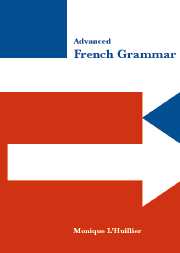Book contents
- Frontmatter
- Contents
- Acknowledgements
- Introduction
- 1 Framework
- 2 Verbs
- 4 Introduction to verbs
- 5 Present indicative
- 6 depuis and other tense markers
- 7 Future
- 8 Imperfect
- 9 Perfect
- 10 Past historic
- 11 Other past tenses
- 12 Subjunctive
- 13 Conditional and the expression of hypothesis
- 14 Imperative
- 15 Infinitive
- 16 Present participle
- 17 Past participle
- 18 Active and passive voices
- 19 Impersonal verbs and the impersonal voice
- 20 Pronominal verbs
- 21 Modals: devoir, pouvoir, vouloir
- 22 savoir and connaître
- 3 Determiners and prepositions
- 4 Nouns, pronouns and modifiers
- 5 Sentences and text
- Appendixes
- Bibliography
- Index
5 - Present indicative
Published online by Cambridge University Press: 05 June 2012
- Frontmatter
- Contents
- Acknowledgements
- Introduction
- 1 Framework
- 2 Verbs
- 4 Introduction to verbs
- 5 Present indicative
- 6 depuis and other tense markers
- 7 Future
- 8 Imperfect
- 9 Perfect
- 10 Past historic
- 11 Other past tenses
- 12 Subjunctive
- 13 Conditional and the expression of hypothesis
- 14 Imperative
- 15 Infinitive
- 16 Present participle
- 17 Past participle
- 18 Active and passive voices
- 19 Impersonal verbs and the impersonal voice
- 20 Pronominal verbs
- 21 Modals: devoir, pouvoir, vouloir
- 22 savoir and connaître
- 3 Determiners and prepositions
- 4 Nouns, pronouns and modifiers
- 5 Sentences and text
- Appendixes
- Bibliography
- Index
Summary
Introduction
The present indicative basically expresses the non-accomplished aspect: it does not specify the limits of the length of the process.
The present is not so much a tense as as kind of ‘threshold’ between what has been (the past) and what is not yet (the future). As this threshold can be envisaged in several ways, the present is not attached solely to the present moment. Thus it has a variety of uses, e.g. it can express the present moment, a variable length of time, or even a past or a future.
The present tense is also used:
– with depuis/depuis que and equivalent expressions, when English uses a past tense: see chapter 6 depuis and Other Tense Markers.
– after si: see chapter 13 Conditional and the Expression of Hypothesis, section 3.2.3.
– to express the recent past: see 3.5 below.
– to express the immediate future: see 3.6 below and chapter 7 Future, section 5.
Formation
The present of the indicative is not particularly easy to conjugate as both regular and irregular verbs in all categories (ER, IR, OIR and RE) can have several radicals (see chapter 4 Introduction to Verbs, section 6.1). Furthermore, the endings can also differ. This chapter examines each verb category in turn and looks at their conjugation peculiarities.
Verbs in ER
The radical is the infinitive minus the ending ER.
- Type
- Chapter
- Information
- Advanced French Grammar , pp. 77 - 91Publisher: Cambridge University PressPrint publication year: 1999



